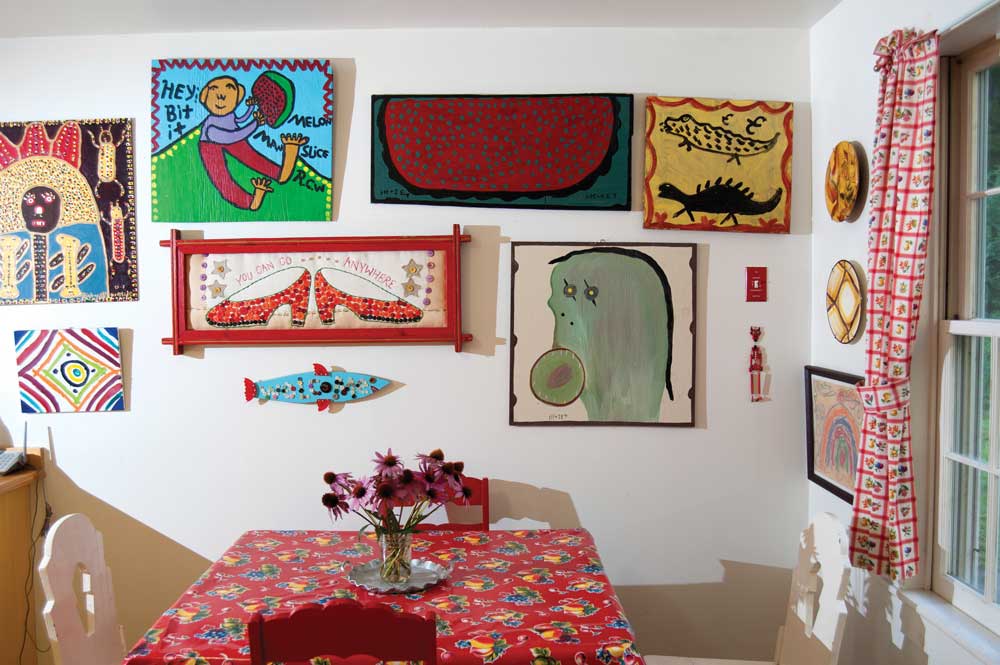The Creative Home
By Amara Projansky | Fall 2013 | Hudson Valley Real Estate Market
To watch someone buy a property and leap into the project with both feet, making it truly their own, is to know admiration. That kind of energy and independence is unusual. The stories we’ve gathered for this issue are about house-truelove, affairs of a lifetime. Each home reflects the owner’s vision, taste, and abilities—these are creative homes. While we’ll be showcasing many professionally designed and built homes in future issues, these pages are about the inventive and self-reliant homeowner.
In a time when we’re used to hiring experts and following trends and fashions, it’s unusual for us to rely on our own wherewithal and sensibility enough to make the considerable investment necessary to actually build a house solo, or to design and construct an ambitious garden. Self-reliance is a character trait that was more common in the past. Just think of the intrepid European settlers of our continent who cleared land, built houses by hand, birthed, raised, schooled, and doctored children without a village, and did whatever else was necessary. What in our time is similar in scope?
We are living in an age of specialization, urbanization, and industrialization. It takes misfits and geniuses to keep the self-reliant gene from going completely extinct. Self-reliance experiences a revival from time-to-time, often in social movements like the homesteaders of the ’60s. Lately the sensibility pops up in the hands of preppers, DIYers, makers, and modern farmers.
Each house profile in this issue is about people who trusted themselves to transform their property, relying on their own vision and abilities. And over time, they allowed their vision to develop and change, yet stay coherent. The owners used their property to engage in a conversation with themselves, a conversation that now we too can enjoy and learn from.
These are the lifers, the ones who’ve been at it for decades, those for whom a full expression of life is completely entwined with their property. These are the people whose extra time and money is already allocated to the next deck or window, or toward adding to a carefully tended collection.
While it’s possible to separate “living” from a “house”—indeed most of us do—a few of us marry the two, and the house itself becomes our life.
By contrast, there are people who love beautiful homes and wish for one—so much so that they buy and furnish something to look like a home, but it’s neither made from personal history nor predilections and passions; it has no DNA. It’s more like a mirage—a fashionable dream, or an accretion of objects bought to imitate another person’s taste, such as an admired designer, or Martha Stewart, or the Design Within Reach catalog buyers.
Whatever kind of homeowner you are, I wish to offer you this: You can’t go wrong. If you decide to let your house become a more honest reflection of you, if you choose to go out on that limb, it will be a worthy adventure. When you choose objects that appeal to you, objects that interest you; when you choose something that needs fixing or improving and you actually invest your effort and time making it a better version of itself; or when you select items that remind you of something important—whether or not you know what it is—you are choosing from your self, and in that is an inbuilt coherence.
There is an idea in the Chinese philosophy of feng shui, that every object in our surroundings has an effect on us. Like most complex ideas, it can be understood in more than one way. The most common application is something like the superstitious sounding injunction to hang a mirror over the cash register for good luck.
A more interesting approach is to realize that each object we live with affects us every time we interact with it. For example, in my home there is a sticky cabinet door to fight with every morning in order to reach the toothpaste—its effect is to increase frustration levels a little, just as the day is beginning. By contrast, every time I fill my bathtub I admire its classic lines and clean white enamel; I appreciate how deep and generous it seems, and whenever I see it—which is every time I go in my bathroom—I’m reminded that I have the opportunity to relax there soon.
In choosing which objects to live with, I choose what I want to remember and how I want to feel. I can curate my own experience—there’s the Noguchi table that inspires me, yes! There’s the crooked wooden ladder I found after looking for so long, yes! There’s the drawing I received from a child with generosity in her eyes, wow!
In the act of choosing, we learn who we are, and thereby become who we are. That’s self-expression. That’s creativity, and it’s also self-reliance.
Your neighbor,
Amara Projansky
